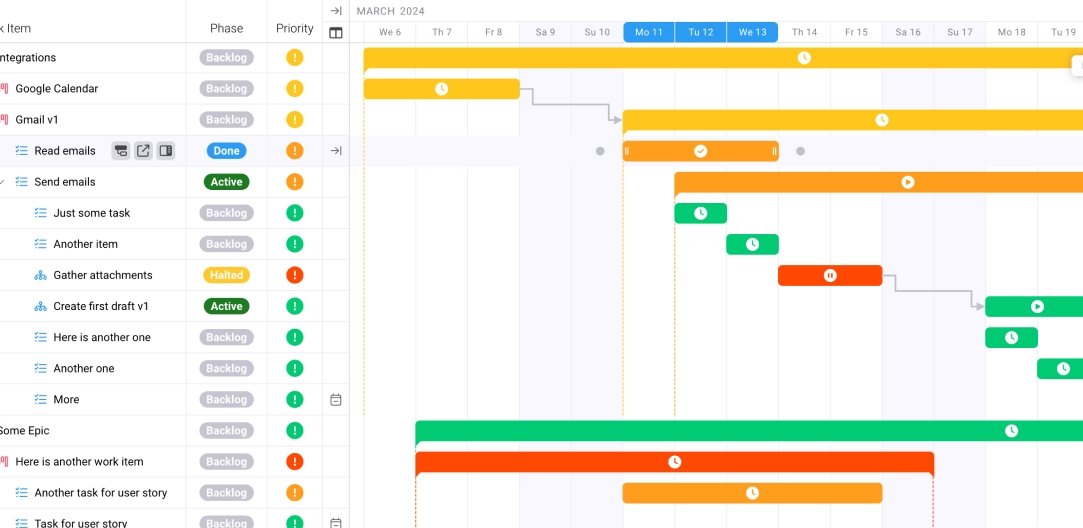
Project Budgeting and Forecasting Best Practices for Marketing Agency CFOs
Key takeaways:
The landscape of project budgeting and forecasting for marketing agency CFOs has transformed dramatically. While marketing budgets have fallen to 7.7% of overall company revenue, the pressure on agency CFOs to deliver accurate financial predictions has never been greater. The traditional approaches to budgeting that served agencies well in predictable times now crumble under the weight of dynamic client demands, irregular revenue streams, and accelerating technological change.
The Current Challenge
Marketing agencies face unique financial challenges that make project budgeting and forecasting particularly complex. Unlike traditional businesses with predictable revenue cycles, agencies navigate a maze of variable costs, fluctuating resource demands, and client expectations that shift mid-project.
29% of agencies see maintaining cash flow as their biggest pain point, highlighting the critical need for more sophisticated financial management approaches. The project-based nature of agency work creates feast-or-famine cycles that traditional forecasting models struggle to accommodate. Add the complexity of managing multiple concurrent projects with different timelines, resource requirements, and profit margins, and the challenge becomes clear.
The consequences of poor project budgeting extend beyond immediate financial strain. Agencies operating without robust forecasting frameworks face cascading problems: resource misallocation leads to project delays, inaccurate pricing erodes margins, and cash flow uncertainty limits growth investments. When CFOs lack reliable financial visibility, strategic decision-making becomes guesswork rather than informed planning.
The Strategic Framework
Building effective project budgeting and forecasting capabilities requires a systematic approach that addresses both the technical and cultural aspects of financial management. The most successful agency CFOs develop frameworks that balance precision with flexibility, allowing for accurate predictions while maintaining the agility to adapt to changing circumstances.
Data-Driven Foundation
40% of global CFOs don't completely trust the accuracy of their organization's financial data, revealing a fundamental challenge that must be addressed before any forecasting framework can succeed. The solution begins with establishing clean, consistent data collection processes across all projects.
Start by standardizing how project costs are captured and categorized. Every hour worked, every expense incurred, and every resource allocated must flow into a centralized system using consistent coding structures. This granular data collection might seem excessive initially, but it provides the foundation for accurate pattern recognition and predictive modeling.
Historical project data becomes invaluable for future forecasting. Track not just final costs but also how budgets evolved throughout project lifecycles. Document why variances occurred, what triggered scope changes, and how different project types performed relative to initial estimates. This institutional knowledge transforms forecasting from educated guessing to empirical prediction.
Technology Integration
80% of CFOs expect companies to use additional automation and digital technologies in their financial operations. For agency CFOs, this means moving beyond spreadsheets to integrated financial planning platforms that connect project management, resource planning, and financial reporting.
Modern forecasting requires real-time data flows between operational and financial systems. When project managers update task completion or resource allocation, these changes should immediately reflect in financial projections. This integration eliminates the lag between operational reality and financial reporting that often blinds CFOs to emerging budget issues.
Rolling Forecast Methodology
Traditional annual budgeting cycles fail to capture the dynamic nature of agency operations. Instead, implement rolling forecasts that extend 12-18 months forward and update monthly based on actual performance and pipeline evolution. This approach provides continuous visibility while maintaining long-term strategic perspective.
Rolling forecasts should incorporate multiple scenarios based on different win rate assumptions, project timing variations, and resource availability constraints. By modeling various outcomes, CFOs can prepare for different futures rather than betting everything on a single projection. This scenario planning becomes particularly valuable when major client relationships are at risk or significant new opportunities emerge.
Implementation Tactics
Establishing Project Budget Templates
Develop standardized budget templates for different project types that reflect your agency's unique service delivery models. These templates should capture typical resource allocations, timeline patterns, and cost structures based on historical performance data.
Start with broad categories—retainer clients, project-based work, and performance campaigns—then refine based on specific service lines. Each template should include baseline assumptions about team composition, hours required by role, third-party costs, and margin targets. These become starting points that project managers adjust based on specific client requirements.
Include contingency allocations that vary by project complexity and client history. New clients or innovative project types might warrant 15-20% contingency reserves, while established relationships with proven project types might only need 5-10%. Document these contingency decisions to refine future risk assessments.
Implementing Variance Analysis Systems
A 1% improvement in forecasting accuracy could save $1.43-3.52 million per year for large businesses. For agencies, even smaller improvements in accuracy can significantly impact profitability.
Create systematic variance analysis processes that compare budgeted versus actual performance at multiple checkpoints throughout project lifecycles. Don't wait until project completion to identify overruns—establish weekly or bi-weekly variance reviews that flag deviations while there's still time to course-correct.
Focus variance analysis on leading indicators rather than just lagging financial metrics. Track metrics like task completion rates, resource utilization trends, and scope change frequency. These operational measures often predict financial variances before they fully materialize in cost reports.
Building Predictive Models
29.3% of businesses in 2024 are using AI to optimize their budgets, and agencies can leverage similar technologies for more accurate forecasting. Start by identifying the variables that most strongly correlate with project profitability in your agency.
Common predictive factors include client industry, project complexity scores, team seniority mix, timeline compression, and seasonal patterns. Use regression analysis on historical data to quantify how these factors impact final project costs and margins. Build these insights into forecasting models that automatically adjust projections based on project characteristics.
Machine learning algorithms can identify patterns humans might miss. For instance, certain combinations of project attributes might consistently lead to scope creep, or specific client behaviors might predict payment delays. Incorporating these insights improves both project budgeting and cash flow forecasting accuracy.
Resource Capacity Planning
Accurate project budgeting depends heavily on realistic resource planning. Agencies with healthy processes achieve margins between 20-30%, but this requires careful balance between resource utilization and capacity reserves.
Develop resource forecasting models that account for both confirmed projects and pipeline opportunities weighted by probability. Map resource requirements across all active and potential projects to identify capacity constraints before they impact project delivery. This forward-looking view enables proactive hiring decisions and helps avoid the costly cycle of rush hiring followed by underutilization.
Consider non-billable time requirements when planning capacity. Training, business development, administrative tasks, and internal initiatives all consume resources that must be factored into overall capacity planning. Agencies that ignore these non-billable demands consistently overcommit resources and compromise project delivery.
Measuring Success
Key Performance Indicators
Only 35% of B2B marketing decision-makers expect budget increases of more than 5%, making efficiency metrics increasingly critical. Track both financial and operational KPIs that provide early warning signs of budgeting issues.
Essential financial KPIs include gross margin by project type, budget variance rates, forecast accuracy percentages, and days sales outstanding. Set targets for each metric based on industry benchmarks and your agency's strategic goals. For example, maintaining forecast accuracy within 5% of actual results represents excellent performance for most agencies.
Operational KPIs complement financial metrics by revealing underlying drivers of financial performance. Monitor resource utilization rates, project completion timelines, scope change frequencies, and client satisfaction scores. These operational measures often predict future financial performance better than historical financial data alone.
Return on Investment Tracking
Organizations with structured cost-benefit analysis frameworks demonstrate 42% higher project success rates. Apply similar rigor to evaluating your budgeting and forecasting investments.
Calculate the ROI of improved forecasting accuracy by quantifying benefits like reduced cost overruns, improved resource utilization, faster collection cycles, and better strategic decision-making. Compare these benefits against the costs of new systems, training, and process changes. Most agencies find that even modest improvements in forecasting accuracy generate substantial returns.
Track how forecasting improvements impact broader business metrics. Better budgeting often leads to improved client satisfaction through more reliable delivery, higher employee satisfaction through better resource planning, and increased profitability through optimized pricing and resource allocation. Document these connections to build organizational support for continued investment in financial management capabilities.
Continuous Improvement Framework
Marketing accounts for 10.1% of overall company budgets as of Fall 2024, but agencies must continuously refine their approach to maximize the value of every dollar spent. Establish formal processes for capturing lessons learned from each project and incorporating these insights into future budgets.
Conduct monthly forecasting accuracy reviews that analyze why projections differed from actual results. Was it scope changes, resource availability issues, external factors, or estimation errors? Categorize variances by root cause to identify systematic improvements needed in your forecasting process.
Create feedback loops between project delivery teams and finance. Project managers possess ground-level insights about what drives project costs and timeline variations. Regular collaboration between delivery and finance teams ensures budgeting models reflect operational reality rather than theoretical assumptions.
Future Considerations
The landscape of project budgeting and forecasting continues evolving rapidly. 53% of marketers are spending at least 50% of their budget on lead generation, reflecting shifting priorities that impact how agencies structure and price their services.
Artificial intelligence and machine learning will increasingly automate routine forecasting tasks while providing more sophisticated predictive insights. CFOs who embrace these technologies early will gain competitive advantages through superior financial visibility and decision-making capabilities. However, technology alone isn't sufficient—success requires combining advanced tools with deep industry knowledge and sound financial principles.
The shift toward value-based pricing models will require new approaches to project budgeting that focus less on hours worked and more on outcomes delivered. This transition demands closer collaboration between finance and delivery teams to understand true value drivers and price accordingly.
Economic uncertainty and market volatility make scenario planning and stress testing essential components of financial planning. Build forecasting models that can quickly adapt to changing conditions, whether that's sudden client losses, unexpected growth opportunities, or broader economic shifts.
Conclusion
Project budgeting and forecasting excellence has become a critical differentiator for marketing agency success. CFOs who master these capabilities don't just improve financial performance—they enable strategic agility, operational efficiency, and sustainable growth. The frameworks and practices outlined here provide a roadmap for transforming project budgeting and forecasting from administrative burden to strategic advantage. By combining robust data management, advanced technology, and continuous improvement processes, agency CFOs can achieve the financial visibility and predictive accuracy needed to thrive in an increasingly complex and competitive landscape.
Frequently Asked Questions
What percentage of revenue should agencies allocate to financial management and forecasting technology?
Most successful agencies invest 2-3% of revenue in financial management systems and processes, including software, training, and dedicated finance personnel beyond basic bookkeeping functions.
How often should project budgets be reviewed and updated during execution?
Project budgets should be reviewed weekly for active projects, with formal reforecasting conducted monthly or at major project milestones, whichever comes first.
What's the ideal contingency percentage for agency project budgets?
Contingency reserves typically range from 5-15% depending on project complexity, client history, and project type, with new clients and innovative projects requiring higher reserves.
How can agencies improve forecasting accuracy with limited historical data?
Start with industry benchmarks, implement rigorous data collection immediately, and use progressive refinement where initial estimates are continuously updated as more data becomes available.
What are the most common causes of budget overruns in agency projects?
The primary causes include scope creep, underestimated resource requirements, inefficient project management processes, poor initial requirements definition, and inadequate change management protocols.
When should an agency consider investing in specialized budgeting and forecasting software?
Agencies typically benefit from specialized software when they exceed $2-3 million in annual revenue or manage more than 10 concurrent projects, as complexity at this scale exceeds spreadsheet capabilities.
How do successful agencies balance forecast accuracy with the need for flexibility?
Leading agencies use rolling forecasts with multiple scenarios, allowing for precise near-term planning while maintaining flexibility for longer-term projections.
What role should project managers play in the budgeting and forecasting process?
Project managers should be active participants, providing ground-level insights about resource requirements, risk factors, and delivery challenges that impact project costs and timelines.
How can agencies account for non-billable time in project budgets?
Factor non-billable time into resource capacity calculations, typically assuming 70-80% billable utilization for production staff and 60-70% for senior team members.
What metrics best predict future project profitability?
Leading indicators include scope change frequency, resource utilization trends, client communication responsiveness, and early milestone achievement rates.









